 |
Chemistry
234
|
LABORATORY SAFETY
Read Chapter 1, especially pp. 15-23, of the textbook before coming to your first laboratory session. You will fill out the Safety-device Location Worksheet during your first laboratory session.
The importance of safety precautions in a Chemistry laboratory cannot be overemphasized.
The following safety rules must be followed. Use common sense when working with chemicals and laboratory apparatus. As safety is an integral part of this course, your TA will be grading you for compliance with these safety rules.
Laboratory Safety Rules
1. You must NOT be in the laboratory without a TA present. The laboratory sessions are four hours in length. You will not be allowed in lab after your lab session has ended.
2. Safety goggles for eye protection must be worn properly in the laboratory at all times. If you need to remove your goggles, step outside the laboratory to do so. Prescription eyeglasses (even with safety lenses) do not provide adequate eye protection, especially from the sides. Therefore, you will be removed from the laboratory if you are found without safety goggles covering your eyes. It is very strongly recommended that you NOT wear contact lenses of any kind in the laboratory. You should read the safety information on contact lenses and laboratory accidents posted outside the lab. Please check with the course instructorif you absolutely need to wear contact lenses. If you get anything in your eyes, use the eye wash station or the eye wash faucet to wash your eyes thoroughly with plenty of water and notify your TA immediately.
3. Lab coat for bodily protection must be worn properly in the laboratory at all times.
4. Closed-toed shoes that completely cover the foot MUST be worn in the laboratory at all times. Sandals or perforated shoes are not permitted, as broken glass and spilled chemicals are constant hazards.
5. Shorts and short skirts (above the ankle) will NOT be allowed. Shirts/blouses should protect the upper body. Loose clothing should not be worn. Do not wear hosiey as it will "melt" upon contact with acid and some chemicals.
6. You MUST note the location of the fire extinguishers, safety showers, eye washes, and first-aid kits in the laboratory, so that you will know where to obtain these items if they are needed. You will fill out the Safety-device Location Worksheet during your first laboratory session.
7. Many of the chemicals used in the laboratory experiments will be new to you. You should become acquainted with the properties of every new chemical you use. The Merck Index and www.chemfinder.com are good sources for finding the properties and toxicities of many organic compounds. Access to material safety data sheets through various web sites can be obtained on the School of Chemical Sciences Safety Resources Web Page at safety.scs.uiuc.edu. All chemicals should be treated as though they are toxic. Compounds can enter the body by being absorbed through the skin, or by being inhaled or ingested. Therefore,
(a) Keep vessels covered. Put the caps back on the solvent bottles immediately. Never evaporate solvents other than water into the atmosphere. Wipe up any spills immediately. In order to check for an odor, hold the sample about a foot away from your face and gently fan the vapors towards your nose. Do not put anything in your mouth.
(b) You should use the gloves that are available. Keep your bench top clean! DO NOT rub your eyes or your face without first washing your hands. If something does get into your eyes, remember to wash your eyes with plenty of water and notify your TA. You should protect your clothing by wearing a lab coat. Always wash your hands thoroughly before leaving the laboratory session. If you have any cuts or scrapes, cover them with band-aids, etc., before coming to the laboratory.
(c) To dilute acids, carefully and slowly add the concentrated acid to the water, never the other way around. This avoids dangerous splattering. "Do like you oughta, add acid to water".
8. Never heat a closed system! Always use boiling chips when heating any liquid, even water. When heating a test tube, never point it at yourself or at anyone else. Never heat flammable solvents (i.e., anything other than water) in an open container with a Bunsen burner.
When you want to use a Bunsen burner, make sure that none of your neighbors is using a flammable solvent and that there are no flammables in the immediate area. Light the match first, then turn on the gas while holding the match close to the top of the burner. Long hair must be tied back. Do not wear garments with floppy sleeves or loose wrist cuffs. Turn off the Bunsen burner immediately when you are finished with it.
9. Do not use cracked or chipped glassware. Examine your glassware for "star" cracks. Broken glassware should be replaced immediately with new glassware from the storeroom. Do not handle broken glass with your hands. Sweep it up, or use a piece of toweling to grasp the pieces. The storeroom has leather gloves to wear while cleaning up broken glassware.
10. Only aqueous solutions (e.g., aqueous acids and bases) may be discarded down the drain. Flush them down with plenty of water. Other waste materials, both liquid and solid, should be disposed of into the properlabeled waste containers located in the hoods. Broken thermometers should be put into jars located in the hoods. Ask your TA to assist you in cleaning up any spilled mercury.
11. In the case of an accident (cuts, burns, reaction to a chemical, etc.), inform your TA immediately. A limited degree of first-aid is available in the storeroom, 469 Noyes Lab. If you are seriously injured, you will be taken to the medical center. Report all accidents immediately.
Your health is more important than your grade in Chem 234!
12. Never pour chemicals directly from the storage containers directly into your reaction vessel.
13. Smoking, eating, and drinking are not permitted in the laboratory. Do not bring food or beverages into the laboratory.
14. No pets are allowed in the laboratory.
14. No "horseplay" is allowed in the laboratory.
16. No radios or CD players are allowed in the laboratory.
A good perception of your surroundings is very important in a chemical laboratory. This state of mind requires your full attention. Take care of yourself and your neighbors. Immediately warn your neighbor if you see him/her doing something dangerous. It is natural for you to feel somewhat confused at times. Do not be hesitate to ask your TA or the storeroom manager for guidance with the use of the laboratory equipment or for advice on safety matters. Please respect the fact that other students must use the common laboratory equipment, such as the balances, melting point apparati, hoods, etc. Take care of this equipment, and clean up your messes immediately.
Safety and Emergency Equipment In 467 Noyes Lab
The Chem 234 laboratory sessions will be held in 467 Noyes Laboratory. This lab contains the following safety and emergency equipment:
|
Fire Blanket
|
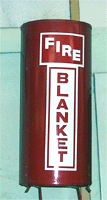 |
|
Fire
Extinguisher
|
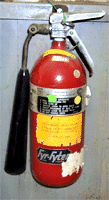 |
|
Overhead
Shower
|
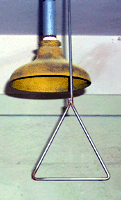 |
| Safety shower with curtain. | 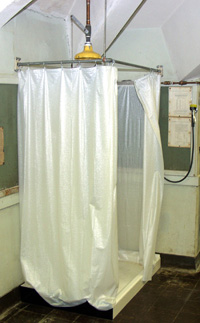 |
|
Eye-Wash
Faucets
|
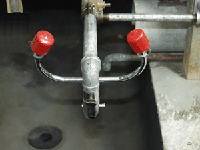 |
| Eye wash station | 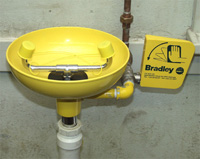 |
| Two drench hoses. |  |
|
Fire
Alarm
|
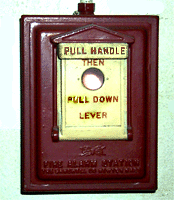 |
|
First
Aid Kit
|
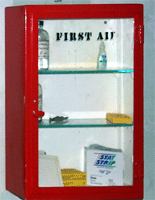 |
Before you begin laboratory work in this course, you must complete the Safety Device Location Worksheet.
.Locate each of the items listed below and mark their locations on the Worksheet by using the symbols shown in the table. Indicate where your own area is located, and then indicate where the six nearest Eye-Wash Faucets are in relation to your work area.
|
Quantity
|
Equipment
|
Symbol
|
|
13
|
Eye-Wash Faucets |
|
|
1
|
Eye-Wash Station |
|
|
2
|
Drench hoses |
|
|
7
|
Overhead Shower |
|
|
1
|
Safety Shower with Curtain |
|
|
1
|
Fire Blanket |
|
|
6
|
Fire Extinguisher |
|
|
1
|
Fire Alarm |
|
|
1
|
First-Aid Box |
|
|
2
|
Exits |
|
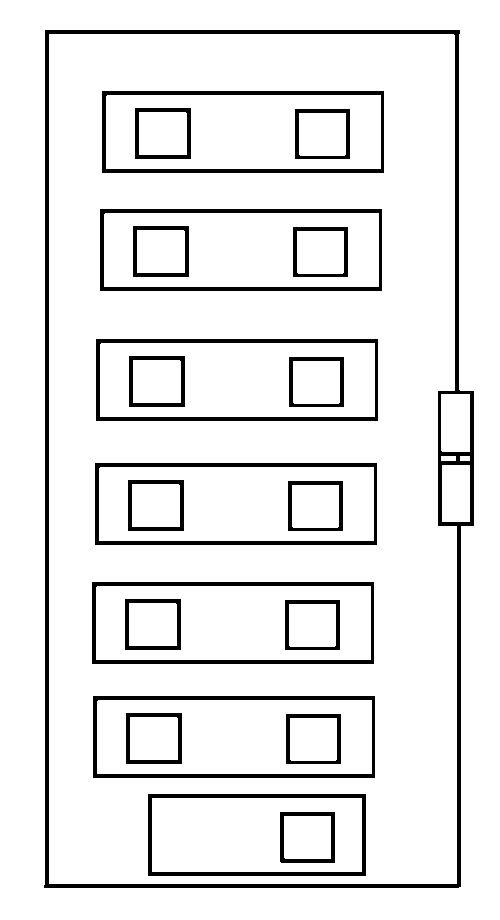
You must wear appropriate clothing in the laboratory at all times. You MUST wear your safety goggles over your eyes at all times in the laboratory! DO NOT wear loose or skimpy clothing (saris, neckties, shorts, halter-tops, overly large or ragged laboratory coats). DO wear closed shoes in the lab. DO NOT wear sandals or perforated shoes. Long hair must be tied back.
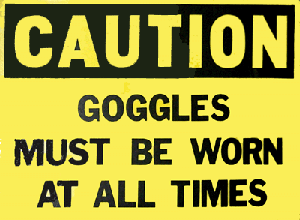
For additional laboratory safety information and resources access the School of Chemical Sciences Web page at safety.scs.uiuc.edu